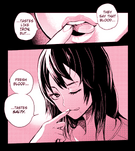m (added major information) Tag: Visual edit |
Tag: Visual edit |
||
| (15 intermediate revisions by 3 users not shown) | |||
| Line 1: | Line 1: | ||
| + | ''Warning: This page discusses mental health and other sensitive topics. If talks of blood, mental illness, or abusive relationships disturb you, tread lightly on this page and if you feel any sort of mental health problems are consuming you, please get in touch with a mental health professional and get whatever help you need. Thank you.'' |
||
| ⚫ | |||
| ⚫ | |||
| ⚫ | |||
| ⚫ | '''Yandere''' (ヤンデレ), derived from the Japanese words yanderu (to be sick) and dererere (to love), describes a character archetype with an unhealthy love-releated obsession that often results in violent outbreaks triggered by unrequited love or disappointment. Another similar type of character would be ''Yangire'', who turns violent regardless of love. |
||
| ⚫ | |||
| + | |||
| ⚫ | It is assumed that the term "Yandere first started to spread among the mainstream media in 2005 because of the release of the visual novel "School Days" and the tv broadcast of the anime "Shuffle!". Shortly after that Yandere has become a popular character archetype in various media. However, even before the term was coined, there already were multiple characters who's attributes would fit under Yandere. According to the Japanese website "Yandere Encyclopedia", the first instance of a Yandere character would be the character Minatsu Tsukishima of the visual novel Kurutta Kajitsu from 1991. In order to monopolize the mc, she starts killing all the women in his life one after another in gruesome ways in |
||
| + | Due to the controversial nature of Yandere as a trope in anime, often criticized of fetishizing or demonizing the mentally ill as well as romanticizing abuse, this aesthetic had to become distinct from the more wholesome [[Lovecore]] on a level beyond their aesthetic differences. Many mentally ill people choose to indulge in Yandere to find like-minded others and reclaim the concept as a form of coping mechanism. |
||
| ⚫ | Mathers Numakichi, the representative of the company Overflow which produced School Days, describes the Yandere boom as "a manifestation of |
||
| ⚫ | |||
== Trivia == |
== Trivia == |
||
| + | In general, Yandere is a character that is often depicted in a state of paraphilia (sexual perversion), manic depression, or co-dependence. The term is generally only used in reference to fiction, and does not hold any actual background in psychatric diagnosis. The "crazy" state of a Yandere is also refered to as "darkening" (闇化) and "blackening" (黒化) in Japanese due to the shadow cast on the face of the character. Fans like the extra ordinary degree of affection that a Yandere shows towards their darling. |
||
| + | However, the definition of Yandere is fluid and often has different meanings depending on the context. For example, on the Japanese website [https://www.new-akiba.com/news/post_7725 New Akiba] it is described as "a moe-type heroine that is suffering from mental illness", and in "[https://k-tai.watch.impress.co.jp/cda/article/news_toppage/37583.html Keitai Watch]" it's described as "a character who is mentally ill". It is sometimes pointed out that the attributes of a Yandere character are reminiscent of borderline personality disorder. |
||
| − | A Yandere tends to be initially loving and caring to someone they have a strong affection for, until their romantic love, admiration, and devotion becomes feisty and mentally destructive in nature through either over protectiveness, violence, brutality or all three combined. In general they don't have many interests or experience many emotions until they meet their s/o. Yanderes could kill their s/o if they believe they were betrayed or cheated on by their s/o whether it is true or not. In short, the reasons mentioned there are: * The unfaltering devotion of the characters to the one they love. * The out-of-the-norm nature of those characters. So, they may seem more "interesting" to some people and/or make the show more intense. A '''Yandere''' has a split personality just like a Tsundere does. Around a lot of people, they act sweet, caring, cute, shy, happy, and any other normal way to act unless someone performs/does any actions that may be unwanted. ... Whoever they '''love''', is the person they '''will''' go full '''Yandere''' for. '''Yanderes''' are typically possessive, extremely jealous, and willing to '''do''' anything for a love interest., '''yanderes''' exist in real life, but very rarely do they commit violent crimes. '''Yanderes''' are outwardly cute and/or innocent girls who become violent and obsessive because of love. Yangires are outwardly '''cute''' and/or innocent girls but suddenly become crazy and violent, due to reasons unrelated to love . ... |
||
| ⚫ | |||
| − | It's a form of possessive obsession. It's not '''killing''' that makes a '''Yandere''', it's the constant threat that they are capable and willing to '''do''' extreme things over their feelings for someone with very little needed to trigger them. This includes '''killing''', but '''does''' not necessarily imply that someone is murderous. |
||
| ⚫ | It is assumed that the term "Yandere" first started to spread among the mainstream media in 2005 because of the release of the visual novel "School Days" and the tv broadcast of the anime "Shuffle!". Shortly after that, Yandere has become a popular character archetype in various media. However, even before the term was coined, there already were multiple characters who's attributes would fit under Yandere. According to the Japanese website "Yandere Encyclopedia", the first instance of a Yandere character would be the character Minatsu Tsukishima of the visual novel "Kurutta Kajitsu" from 1991. In order to monopolize the mc, she starts killing all the women in his life one after another in gruesome ways in an attempt to make the him commit suicide just so she can stay with his corpse forever. The term Yandere itself was first coined by NekoNeko Soft to describe the side character Sasai Yuuna who appears in chapter 3 of their visual novel "Gin'iro". |
||
| ⚫ | Mathers Numakichi, the representative of the company Overflow which produced School Days, describes the Yandere boom as "a manifestation of wanting to seek more steadfastness and favor towards oneself". When asked regarding one of the heroines, Katsura Kotonoha, being labeled as Yandere, he answered, "I wasn't aiming for a Yandere character, so it was more of a lucky coincidence rather than something I "created" on purpose'". He also pointed out that the visual elements of the character were kind of mixed, and stated that "Both tsundere and yandere were a reflection of that time, people wanted to bring a person's inside to the outside". |
||
| − | It was always quite popular amongst the anime community, however, it rose in popularity among the general public thanks to the videogame Yandere Simulator in 2015 and 2016, however, with time, the popularity of the game has been in a steady decline due to its controversial creator.<br /> |
||
| + | |||
| ⚫ | |||
| + | |||
| + | == Visuals == |
||
| + | Common motifs are anime and manga screencap edits of yandere characters such as Gasai Yuno, pastel text message edits, knives, blood, gore, and fetish gear. There is overlap with the Japanese art movement ero-guro, often shortened to guro, which is associated with the [[Gurokawa]] aesthetic. |
||
== Media == |
== Media == |
||
| + | |||
| + | === Characters === |
||
* Satou (Happy Sugar Life) |
* Satou (Happy Sugar Life) |
||
| Line 33: | Line 41: | ||
*Katsura Kotonoha (School Days) |
*Katsura Kotonoha (School Days) |
||
*Lamperogue Rolo (Code Geass) |
*Lamperogue Rolo (Code Geass) |
||
| + | *Ayano Aishi (Yandere Simulator) |
||
| + | *Himiko Toga (My Hero Academia) |
||
| + | *Monika Koide-Nicolaides (Doki Doki Literature Club!) |
||
| + | |||
| + | == Music == |
||
| + | |||
| + | === Spotify Playlists === |
||
| + | |||
| + | *[https://open.spotify.com/playlist/0Qno1yLMlHyavNJb2qXmHr?si=qm-Y2VlKSC-9e4zYTByT3w YandereCore 🔪❤️ Spotify playlist by Masked Angel] |
||
| + | *[https://open.spotify.com/playlist/5PZm4uBFAL5OnIlb96fhXp?si=OENub9G4S5WR48tEUjv0dg Yanderecore Spotify playlist by kristinenb98] |
||
| + | *[https://open.spotify.com/playlist/2JSKaKnp7plfvJQnJflUKB?si=9u6LlJDGR6uIv-1QOwkuOQ YandereCore Spotify playlist by moonlitdustball] |
||
| + | *[https://open.spotify.com/playlist/0Ti9JniZGtS5n4vZZh0TWA?si=ok_7z9OgSzCHsOxNme8BZA ⚠️YANDERECORE⚠️ Spotify playlist by NagitoKomaeda] |
||
| + | *[https://open.spotify.com/playlist/0gHueMjaY7qhYsL6uICuNT?si=BqRs9bhUQ3OvWiqFM7ZHFQ YANDERECORE (BrAiNfUcK V2) Spotify playlist by VORPAL2K] |
||
| + | *[https://open.spotify.com/playlist/5aDFL7eJGzc3WSmP3I5bkX?si=iz-TaJk2QACrLq3rQ_EJRw D̶̼̾̆͝ę̴͔͕͎̫̩̐ͅͅạ̴̖͈͚͎̭̳͉̝̺̊̂d̶̛͔̺̻̼͆̐̈́̒͑ ̷̨̧̘̙̰̼̬̏̒̈̎̓ͅX̷̧̡̛̞̯̣͓͍͇̻̐̀̓͊̿D̷̨̡̺̭̻͉̄ Spotify playlist by nugget_030] |
||
| + | * |
||
| + | *[https://m.youtube.com/watch?v=Oo0sqHqWKHk Yandere by Jazmin bean on YouTube] |
||
| + | *[https://m.youtube.com/playlist?list=PLXHYrfDjVCBY65f-FJuLnKY3aN0FdjmE5 Jazmin Bean playlist (yandere-ish music) on YouTube] |
||
== Gallery == |
== Gallery == |
||
| + | <gallery widths="135" orientation="landscape" spacing="small"> |
||
| − | <gallery> |
||
| − | + | Yanderecore.jpg |
|
| + | Tumblr pdikkwTtT21xb48qto1 540.png|Why having a Yandere for a girlfriend may not be the best idea... |
||
| + | Tumblr 91e7fd66af048c929eb86b1935d536d0 2139d7a4 540.gif |
||
| + | Tumblr 115c494d3904c20c4e19c8e3feb97b05 4c47f269 540.gif |
||
| + | 12.gif |
||
| + | Yandere Aesthetic.jpg |
||
| + | Yandere Aesthetic e.jpg |
||
| + | Yandere Aesthetic ea.jpg |
||
| + | Tenor (13).gif|Ayano Aishi |
||
| + | 2ba2cac30e69ad7db33af5beb3662134.jpg|とが! とが ひみこ! |
||
| + | Faafdd8f63cfa22393ea229de18cbb73.jpg|Genocider Syo |
||
| + | C5bb5d51cdd4e01b22f59957940ebb36.jpg |
||
| + | Soulmates.jpg |
||
| + | Unstable.jpg |
||
| + | I WILL STAB YOU.jpg |
||
| + | 2007aesthetic.jpg |
||
| + | 2007.jpg.png |
||
| + | Yan.jpeg |
||
| + | Tumblr 2f1a5ff92821db1854b36e73d3bf5653 7d51729d 500.gif|satou from happy sugar life |
||
| + | Yukakopt4.gif |
||
</gallery> |
</gallery> |
||
| − | [[Category:Candidates for Deletion]] |
||
[[Category:Japanese]] |
[[Category:Japanese]] |
||
Revision as of 01:50, 14 June 2021
Warning: This page discusses mental health and other sensitive topics. If talks of blood, mental illness, or abusive relationships disturb you, tread lightly on this page and if you feel any sort of mental health problems are consuming you, please get in touch with a mental health professional and get whatever help you need. Thank you.
Yandere (ヤンデレ), derived from the Japanese words yanderu (to be sick) and dererere (to love), describes a character archetype with an unhealthy love-releated obsession that often results in violent outbreaks triggered by unrequited love or disappointment. Another similar type of character would be Yangire, who turns violent regardless of love.
Due to the controversial nature of Yandere as a trope in anime, often criticized of fetishizing or demonizing the mentally ill as well as romanticizing abuse, this aesthetic had to become distinct from the more wholesome Lovecore on a level beyond their aesthetic differences. Many mentally ill people choose to indulge in Yandere to find like-minded others and reclaim the concept as a form of coping mechanism.
Trivia
In general, Yandere is a character that is often depicted in a state of paraphilia (sexual perversion), manic depression, or co-dependence. The term is generally only used in reference to fiction, and does not hold any actual background in psychatric diagnosis. The "crazy" state of a Yandere is also refered to as "darkening" (闇化) and "blackening" (黒化) in Japanese due to the shadow cast on the face of the character. Fans like the extra ordinary degree of affection that a Yandere shows towards their darling.
However, the definition of Yandere is fluid and often has different meanings depending on the context. For example, on the Japanese website New Akiba it is described as "a moe-type heroine that is suffering from mental illness", and in "Keitai Watch" it's described as "a character who is mentally ill". It is sometimes pointed out that the attributes of a Yandere character are reminiscent of borderline personality disorder.
History
It is assumed that the term "Yandere" first started to spread among the mainstream media in 2005 because of the release of the visual novel "School Days" and the tv broadcast of the anime "Shuffle!". Shortly after that, Yandere has become a popular character archetype in various media. However, even before the term was coined, there already were multiple characters who's attributes would fit under Yandere. According to the Japanese website "Yandere Encyclopedia", the first instance of a Yandere character would be the character Minatsu Tsukishima of the visual novel "Kurutta Kajitsu" from 1991. In order to monopolize the mc, she starts killing all the women in his life one after another in gruesome ways in an attempt to make the him commit suicide just so she can stay with his corpse forever. The term Yandere itself was first coined by NekoNeko Soft to describe the side character Sasai Yuuna who appears in chapter 3 of their visual novel "Gin'iro".
Mathers Numakichi, the representative of the company Overflow which produced School Days, describes the Yandere boom as "a manifestation of wanting to seek more steadfastness and favor towards oneself". When asked regarding one of the heroines, Katsura Kotonoha, being labeled as Yandere, he answered, "I wasn't aiming for a Yandere character, so it was more of a lucky coincidence rather than something I "created" on purpose'". He also pointed out that the visual elements of the character were kind of mixed, and stated that "Both tsundere and yandere were a reflection of that time, people wanted to bring a person's inside to the outside".
In the late 00s, the term Yandere also spread among the overseas anime community, and even western games started to incoorperate this character archetype.
Visuals
Common motifs are anime and manga screencap edits of yandere characters such as Gasai Yuno, pastel text message edits, knives, blood, gore, and fetish gear. There is overlap with the Japanese art movement ero-guro, often shortened to guro, which is associated with the Gurokawa aesthetic.
Media
Characters
- Satou (Happy Sugar Life)
- Yamagishi Yukako (JoJo's Bizarre Adventure: Diamond Is Unbreakable)
- Griffith (Berserk)
- Fuyou Kaede (Shuffle)
- Himeji Mizuki (Baka To Test)
- Gasai Yuno (Mirai Nikki)
- Sonozaki Shinon (Higurashi: When They Cry)
- Lucy (Elven Lied)
- Shimizu Megumi (Shiki)
- Nishikinomiya Anna (Shimoneta)
- Tsukiyama Shuu (Tokyo Ghoul)
- Hiyama Akane (Love Tyrant)
- Amane Misa (Death Note)
- Katsura Kotonoha (School Days)
- Lamperogue Rolo (Code Geass)
- Ayano Aishi (Yandere Simulator)
- Himiko Toga (My Hero Academia)
- Monika Koide-Nicolaides (Doki Doki Literature Club!)
Music
Spotify Playlists
- YandereCore 🔪❤️ Spotify playlist by Masked Angel
- Yanderecore Spotify playlist by kristinenb98
- YandereCore Spotify playlist by moonlitdustball
- ⚠️YANDERECORE⚠️ Spotify playlist by NagitoKomaeda
- YANDERECORE (BrAiNfUcK V2) Spotify playlist by VORPAL2K
- D̶̼̾̆͝ę̴͔͕͎̫̩̐ͅͅạ̴̖͈͚͎̭̳͉̝̺̊̂d̶̛͔̺̻̼͆̐̈́̒͑ ̷̨̧̘̙̰̼̬̏̒̈̎̓ͅX̷̧̡̛̞̯̣͓͍͇̻̐̀̓͊̿D̷̨̡̺̭̻͉̄ Spotify playlist by nugget_030
- Yandere by Jazmin bean on YouTube
- Jazmin Bean playlist (yandere-ish music) on YouTube




















